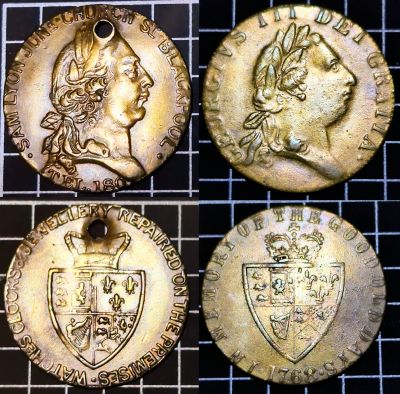An interesting advertising ISG variant
Obverse

We’ve previously looked at another Imitation Spade Guinea (ISG) token. These are gambling tokens produced in the UK in the 1800s and early 1900s. They come in many varieties, although there are a handful of main types. The previous piece we covered was an “In Memory” type. Those are generic pieces with a King George III obverse not dissimilar to a coin of King George. The reverse of that type has “In memory of the good old days” or similar around the reverse. Today’s piece is an “advertising” piece. Essentially, a broadly similar design, but advertising a particular company.
The obverse has a portrait of King George III; however, the text is different. It reads: “Sam Lyon Junr. Church St. Blackpool.” with “Tel 180” under the bust.
The Lyon family watch making & jewellery business was founded by Lemuel Lyon born in Germany circa 1796. The business lasted until the mid -20th century.

A 1940’s photo of the Sam Lyon Junr. shop front situated at 8 -10 Church Street Blackpool, photo credit LucasCampbellBlog
Reverse

Like the Good old times piece, the reverse of the Sam Lyon token, features the crowned “Spade” style coat-of-arms. Again, the lettering around the edge is different. This time reading “Watches clocks and jewellery repaired on the premises”. Here is an image of one of Sam Lyon Jnr’s clocks:

SAM LYON JUNr BLACKPOOL ENGLISH bracket antique clock in a beautiful mahogany case with silvered dial, brass mask, pieced brass rear door, striking Westminster chimes and one of the last ENGLISH MAKERS. Circa 1910s. Photo credit: Antiques-atlas.com
Note on the obverse of the token, that there are multiple die breaks around the lettering. That is where part of the die (which forms the design stamped onto the token) has broken away, leaving a “cud”; a small raised area of metal where there should not be. This is most prominent in the W in “watches”, C in “clocks” and O in “on”. The key reference for imitation spade guinea tokens is “A Thousand Guineas Plus. A Checklist of Imitation Guineas and their Fractions” by W. Bryce Neilson and Martin R. Warburton, published by Galata. This piece is the only advertising piece for this company. Listed as #8040, the photo in the book doesn’t appear to have the die cracks my example does. The image on LucasCampbellBlog only shows the obverse, which doesn’t have the same deterioration as the obverse. My piece, unlike the other two I’ve seen pictures of, is holed, indicating that this may not have been as common. There are some pieces generally found holed, and Neilson and Warburton provide a checklist of these in the guide.
Comparison
It’s also worth a quick comparison of this piece with the earlier In Memory piece. Although similar at first glance, the differences (aside from the text) are more obvious when shown side by side:

On the obverse, note the portrait on the Sam Lyon piece appears thinner, the ribbon at the back of the head is different, and the leaves in the hair are in different places.
On the reverse, the crowns on the shield are quite different, the Irish harp (lower-left) is smaller in the In-Memory piece, while the fleur-de-lis (top-right) are larger.
The text is quite near the edge of the token in both cases, although this is not always the case.


Leave a Reply